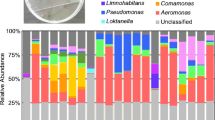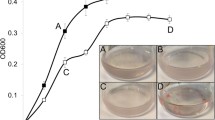Abstract
‘Ferroplasma acidarmanus’ Fer1 is an iron-oxidizing extreme acidophile isolated from the Iron Mountain mine, California, USA. This archaeon is predominantly found in biofilm-associated structures in the environment, and produces two distinct biofilm morphologies. Bioinformatic analysis of the ‘F. acidarmanus’ Fer1 genome identified genes annotated as involved in attachment and biofilm formation. No putative quorum sensing signaling genes were identified and no N-acyl homoserine lactone-like compounds were found in ‘F. acidarmanus’ Fer1 biofilm supernatant. Scanning confocal microscopy analysis of biofilm development on the surface of pyrite demonstrated the temporal and spatial development of biofilm growth. Furthermore, two-dimensional polyacrylamide gel electrophoresis was used to examine differential protein expression patterns between biofilm and planktonic populations. Ten up-regulated proteins were identified that included six enzymes associated with anaerobic growth, suggesting that the dominating phenotype in the mature biofilm was associated with anaerobic modes of growth. This report increases our knowledge of the genetic and proteomic basis of biofilm formation in an extreme acidophilic archaeon.


Similar content being viewed by others
Abbreviations
- EPS:
-
Extracellular polymeric substances
- HSLs:
-
N-acyl homoserine lactones
- MSM:
-
Mineral salts medium
- 2D-PAGE:
-
2-Dimensional polyacrylamide gel electrophoresis
- SAM:
-
S-adenosylmethionine
- MALDI-TOF:
-
Matrix-assisted laser desorption ionization time-of-flight
References
Bond PL, Smriga SP, Banfield JF (2000) Phylogeny of microorganisms populating a thick, subaerial, predominantly lithotrophic biofilm at an extreme acid mine drainage site. Appl Environ Microbiol 66:3842–3849
Bushley KE, Turgeon BG (2010) Phylogenomics reveals subfamilies of fungal nonribosomal peptide synthetases and their evolutionary relationships. BMC Evol Biol 10:26
Bushley KE, Ripoll DR, Turgeon BG (2008) Module evolution and substrate specificity of fungal nonribosomal peptide synthetases involved in siderophore biosynthesis. BMC Evol Biol 8:328
Castro M, Ruiz LM, Barriga A, Jerez CA, Holmes D, Guiliani N (2009) C-di-GMP pathway in biomining bacteria. Adv Mat Res 71–73:223–226
Crundwell F (1996) The formation of biofilms of iron-oxidising bacteria on pyrite. Miner Eng 9:1081–1089
Davey ME, O’Toole GA (2000) Microbial biofilms: from ecology to molecular genetics. Microbiol Mol Biol Rev 64:847–867
Donlan RM (2002) Biofilms: microbial life on surfaces. Emerg Infect Dis 8:881–890
Dopson M, Lindström EB (1999) Potential role of Thiobacillus caldus in arsenopyrite bioleaching. Appl Environ Microbiol 65:36–40
Dopson M, Baker-Austin C, Bond PL (2004a) First use of 2-dimensional polyacrylamide gel electrophoresis to determine phylogenetic relationships. J Microbiol Methods 58:297–302
Dopson M, Baker-Austin C, Hind A, Bowman JP, Bond PL (2004b) Characterization of Ferroplasma isolates and Ferroplasma acidarmanus sp nov., extreme acidophiles from acid mine drainage and industrial bioleaching environments. Appl Environ Microbiol 70:2079–2088
Dopson M, Baker-Austin C, Bond PL (2005) Analysis of differential protein expression during growth states of Ferroplasma strains and insights into electron transport for iron oxidation. Microbiology 151:4127–4137
Dopson M, Baker-Austin C, Bond P (2007) Towards determining details of anaerobic growth coupled to ferric iron reduction by the acidophilic archaeon ‘Ferroplasma acidarmanus’ Fer1. Extremophiles 11:159–168
Edwards KJ, Bond PL, Gihring TM, Banfield JF (2000) An archaeal iron-oxidizing extreme acidophile important in acid mine drainage. Science 287:1796–1799
Farah C, Vera M, Morin D, Haras D, Jerez CA, Guiliani N (2005) Evidence for a functional quorum-sensing type AI-1 system in the extremophilic bacterium Acidithiobacillus ferrooxidans. Appl Environ Microbiol 71:7033–7040
Fu JH, Hu YH, Qiu GZ, Liu JS, Xu J (2004) Biofilm forming and leaching mechanism during bioleaching chalcopyrite by Thiobacillus ferrooxidans. Trans Nonferr Metals Soc China 14:383–387
Golyshina OV, Timmis KN (2005) Ferroplasma and relatives, recently discovered cell wall-lacking archaea making a living in extremely acid, heavy metal-rich environments. Environ Microbiol 7:1277–1288
Harms C, Meyer MA, Andreesen JR (1998) Fast purification of thioredoxin reductases and of thioredoxins with an unusual redox-active centre from anaerobic, amino-acid-utilizing bacteria. Microbiology 144:793–800
Henke JM, Bassler BL (2004) Bacterial social engagements. Trends Cell Biol 14:648–656
Hesketh A et al (2002) The GlnD and GlnK homologues of Streptomyces coelicolor A3(2) are functionally dissimilar to their nitrogen regulatory system counterparts from enteric bacteria. Mol Microbiol 46:319–330
Karatan E, Watnick P (2009) Signals, regulatory networks, and materials that build and break bacterial biofilms. Microbiol Mol Biol Rev 73:310–347
Karatan E, Duncan TR, Watnick PI (2005) NspS, a predicted polyamine sensor, mediates activation of Vibrio cholerae biofilm formation by norspermidine. J Bacteriol 187:7434–7443
Ma K, Hutchins A, Sung S-JS, Adams MWW (1997) Pyruvate ferredoxin oxidoreductase from the hyperthermophilic archaeon, Pyrococcus furiosus, functions as a CoA-dependent pyruvate decarboxylase. Proc Natl Acad Sci USA 94:9608–9613
McClean K et al (1997) Quorum sensing and Chromobacterium violaceum: exploitation of violacein production and inhibition for the detection of N-acylhomoserine lactones. Microbiology 143:3703–3711
Moons P, Michiels CW, Aertsen A (2009) Bacterial interactions in biofilms. Crit Rev Microbiol 35:157–168
Oosthuizen MC et al (2002) Proteomic analysis reveals differential protein expression by Bacillus cereus during biofilm formation. Appl Environ Microbiol 68:2770–2780
Paggi RA, Martone CB, Fuqua C, De Castro RE (2003) Detection of quorum sensing signals in the haloalkaliphilic archaeon Natronococcus occultus. FEMS Microbiol Lett 221:49–52
Rivas M, Seeger M, Holmes DS, Jedlicki E (2005) A lux-like quorum sensing system in the extreme acidophile Acidithiobacillus ferrooxidans. Biol Res 38:283–297
Rivas M, Seeger M, Jedlicki E, Holmes DS (2007) Second acyl homoserine lactone production system in the extreme acidophile Acidithiobacillus ferrooxidans. Appl Environ Microbiol 73:3225–3231
Rohwerder T, Gehrke T, Kinzler K, Sand W (2003) Bioleaching review part A. Progress in bioleaching: fundamentals and mechanisms of bacterial metal sulfide oxidation. Appl Microbiol Biotechnol 63:239–248
Rolfe BG, Gresshoff PM, Shine J (1980) Rapid screening for symbiotic mutants of Rhizobium and white clover. Plant Sci Lett 19:277–284
Ruiz LM et al (2008) AHL communication is a widespread phenomenon in biomining bacteria and seems to be involved in mineral-adhesion efficiency. Hydrometallurgy 94:133–137
Sand W, Gehrke T, Jozsa P-G, Schippers A (2001) (Bio)chemistry of bacterial leaching-direct vs indirect bioleaching. Hydrometallurgy 59:159–175
Seaver LC, Imlay JA (2001) Alkyl hydroperoxide reductase is the primary scavenger of endogenous hydrogen peroxide in Escherichia coli. J Bacteriol 183:7173–7181
Simm R, Morr M, Kader A, Nimtz M, Romling U (2004) GGDEF and EAL domains inversely regulate cyclic di-GMP levels and transition from sessility to motility. Mol Microbiol 53:1123–1134
Tyson GW et al (2004) Community structure and metabolism through reconstruction of microbial genomes from the environment. Nature 428:37–43
Vera M, Rohwerder T, Bellenberg S, Sand W, Denis Y, Bonnefoy V (2009) Characterization of biofilm formation by the bioleaching acidophilic bacterium Acidithiobacillus ferrooxidans by a microarray transcriptome analysis. Adv Mat Res 71–73:175–178
Vu B, Chen M, Crawford RJ, Ivanova EP (2009) Bacterial extracellular polysaccharides involved in biofilm formation. Molecules 14:2535–2554
Walt A, Kahn ML (2002) The fixA and fixB genes are necessary for anaerobic carnitine reduction in Escherichia coli. J Bacteriol 184:4044–4047
Wilmes P, Remis JP, Hwang M, Auer M, Thelen MP, Banfield JF (2008) Natural acidophilic biofilm communities reflect distinct organismal and functional organization. ISME J 3:266–270
Yocum RR, Perkins JB, Howitt CL, Pero J (1996) Cloning and characterization of the metE gene encoding S-adenosylmethionine synthetase from Bacillus subtilis. J Bacteriol 178:4604–4610
Acknowledgments
Drs. Jillian F. Banfield and Katrina J. Edwards are gratefully acknowledged for provision of ‘F. acidarmanus’ Fer1 and helpful discussions. Polished pyrite chips were kindly prepared by Åke Sandström. The technical assistance of Martina Maidment and Lynda Flegg was greatly appreciated and Dr. Paul Thomas is acknowledged for assistance with the confocal microscopy. Trypsin digests and MALDI-TOF analysis of excised protein spots was carried out at the John Innes Centre, Norwich. This work was funded by a BBSRC Research grant and the John and Pamela Salter Charitable Trust.
Author information
Authors and Affiliations
Corresponding author
Additional information
Communicated by A. Driessen.
Electronic supplementary material
Below is the link to the electronic supplementary material.
Rights and permissions
About this article
Cite this article
Baker-Austin, C., Potrykus, J., Wexler, M. et al. Biofilm development in the extremely acidophilic archaeon ‘Ferroplasma acidarmanus’ Fer1. Extremophiles 14, 485–491 (2010). https://doi.org/10.1007/s00792-010-0328-1
Received:
Accepted:
Published:
Issue Date:
DOI: https://doi.org/10.1007/s00792-010-0328-1




